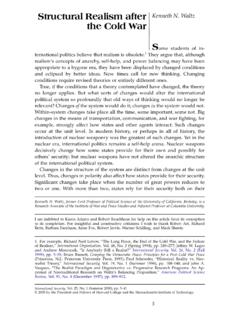Transcription of Anarchy in International Relations Theory: The Neorealist ...
1 Anarchy in International Relations theory : The Neorealist -Neoliberal Debate Neorealism and its Critics. by Robert O. Keohane; Neorealism and Neoliberalism: The Contemporary Debate. by David A. Baldwin Review by: Robert Powell International Organization, Vol. 48, No. 2 (Spring, 1994), pp. 313-344. Published by: The MIT Press Stable URL: . Accessed: 20/12/2011 19:43. Your use of the JSTOR archive indicates your acceptance of the Terms & Conditions of Use, available at . JSTOR is a not-for-profit service that helps scholars, researchers, and students discover, use, and build upon a wide range of content in a trusted digital archive. We use information technology and tools to increase productivity and facilitate new forms of scholarship.
2 For more information about JSTOR, please contact The MIT Press is collaborating with JSTOR to digitize, preserve and extend access to International Organization. Anarchyin International relationstheory:the debate Neorealist -neoliberal RobertPowell Robert0. Keohane, Its York: Columbia Press,1986. University The Contemporary David A. Baldwin, Neoliberalism: Debate. New York: ColumbiaUniversityPress,1993. Two ofthemostinfluential contemporary approachesto internationalrelations theoryare neorealism and debate between these two approacheshas dominatedmuchof internationalrelationstheoryforthe last decade. It is now commonplaceforan articleabout some aspect of interna- tionalrelationstheoryto beginbylocatingitselfin termsof thisdebate.
3 These two approaches and the debate between them have failed to contributeas muchas theymighthave to approaches sufferfromserious internalweaknesses and limitationsthat the Neorealist - neoliberaldebate oftenhas tendedto obscureratherthanto we have exposedand clarifiedtheseweaknessesand limitations, we willbe able to see severalimportantdirectionsforfuturetheor eticalwork. Two books,Neorealismand Its Criticsand Neorealismand Neoliberalism: The Contemporary Debate,makesignificant to former contributions offereda wide-ranging critiqueof neorealismwhen it was publishedin 1986. The latter,whichhas justbeen published,is morenarrowly takesup where some of the critiquesin Neorealismand Its reviewof thesetwocomplementary volumesaffordsan excellentopportunity to beginto identifysome of the weaknesses and limitations that the Neorealist -neoliberal debate frequently has obscured.
4 Frieden,JoanneGowa, JosephGrieco, ErnstHaas, Peter I am gratefulto Carol Evans, Jeffry Katzenstein,Robert Keohane, David Lake, JamesMorrow,JohnOdell, JaniceGross Stein,and KennethWaltz fortheirthoughtful commentsand criticisms of an also thankGreg Louden and Michael Sinatra for invaluable research assistance. I gratefullyacknowledgethe supportof a grantfromtheNationalScience Foundation,no. SES-921959. 48, 2, Spring1994,pp. 313-44. IntemationalOrganization ?3 1994 byThe 10 Foundationand the MassachusettsInstituteofTechnology 314 InternationalOrganization In thisreview,I discussfourbroad avenues of criticismthatthese volumes take in evaluatingneorealismand specifically KennethWaltz's formulation of it.' The firstthree avenues are the originsof states' preferences,the agent- structureproblem,and Waltz's specificdefinition of criticisms generallydo notchallengethe focus instead on the limitationsof the firsttwo centeron what neorealismtakes forgranted, , preferencesand intersubjective meanings and understandings.
5 The thirdcriticismfindsWaltz'sdefinition ofstructuretoo fourthavenue of criticismchallenges the internallogic of argues that conclusionsclaimed to followfromthe assumptionsof neorealismactuallydo not. The Neorealist -neoliberaldebate lies alongthisfourthavenue. Three issues lie at the center of the Neorealist -neoliberaldebate. In reviewing theseissues,I tryto bringimportantimplicitassumptionsto thefore and showthatthoseassumptionsaccountformanyof theimportant differences betweenthe two ,manyof the differences thathave been thoughtto be significant, such as the difference betweenrelativeand absolute gains,are not. The firstissue at the heartof the debate is the meaningand implicationsof anarchyhas servedas a central organizingconceptformuchof International relationstheory,the emphasison anarchyis have oftenbeen taken to be the implicationsof anarchydo not reallyfollowfromthe assumptionof ,these implicationsresultfromother implicitand unarticulatedassumptionsabout the states'strategicenvironment.
6 The second centralissue is the problemof absolute and relativegains. I. argue that the controversy surroundingthis problemgenerallyhas mistaken effects for causes and that this mistake has handicapped analysis of the problemof specifically, I tryto demonstrate that the internationalrelationsliteraturegenerall yholds, if at times only implicitly so, thatthe extentto whicha stateis concernedabout relativegains depends on its strategicenvironment,for example, the offense-defense balance and the intensity of the ifthisis the case, then the degree to whicha state is concernedabout relativegains is part of the outcometo be explained:it is an effectand not a cause. The extentto whicha stateis concernedabout relativegains,therefore, does not explainthe levelof realizationshould refocusour attentionon whatdeterminesthedegreeof a state'sconcernabout relativegains.
7 The thirdissue is the tensionbetweencoordinationand distribution. There are oftenmanyways to realize the joint gains fromcooperation,and these alternativesoften lead to differentdistributionsof those gains. Thus, the potentialforjoint gains usuallycreates distributionaldisputes that tend to concernsonlyrecentlyhave 1. KennethWaltz, theory Politics(Reading, Mass.: Addison-Wesley,1979). ofIntemational Neorealismand neoliberalism 315. begun to receiveattentionin the debate betweenneorealismand neoliberal- ism,theyhold the promiseof clarifyingsome of the questionsthatactuallydo dividethesetwoapproaches. Neorealismand thestructuralapproach Much of the Neorealist -neoliberaldebate can be seen as a reactionto Waltz's Theoryof International Politics and a response to those brief discussionoftwoofthatbook's primary objectivesis essentialto understanding the One objectivewas to reiterate,reinforce,and refinea line of argumentWaltzbegan inMan, theState,and ,he had underscored the importanceof the causes of internationaloutcomes,say the cause ofwar,"in the natureand behaviorof men.
8 Wars resultfromselfishness,frommisdirectedagg ressive impulses,fromstupidity."4 Second-imageexplanationslocate causes in the internal structureof the state. Imperialism,for example, results from a particularinternaleconomicstructurelike capitalism;similarly, International peace resultsfroma particularformofgovernment Appealing to Rousseau's staghuntand alludingto the thenrecentdevelopmentof game theory ,Waltz argued that first-and second-imageexplanationswere insuffi- a situationentailingstrategicinterdependen ce,such as thatof the great powers, an actor's optimal strategydepends on the other actors'. , therefore,we want to explainwhat the actorswill do, then,in additionto lookingat the attributesof the actors,we must also look to the constraintsthat definethe strategicsettingin whichthe thirdimagelocates causes "withinthestatesystem.
9 "7. A simple example from microeconomictheoryillustratesthe potential importanceof third-image price is higherand the outputis lower in a monopolized marketthan in a competitiveone. But first-and second-imageaccounts,whichWaltzcollectiv ely calls reductiveexplanationsin Theoryof IntemationalPolitics,do not explain these both markets,the attributes of the actors,whichare firmsin thiscase, are identical: everyfirmtriesto maximizeits profitsand consequentlyproducesthe level of outputat whichmarginalcost equals accountsforthe variationin price and outputbetween these marketsis not variationin the attributesoftheunitsbutvariationin theenvironments or marketstructures in whichtheyact. This is theessence ofthethirdimage.
10 2. For a summaryof Waltz's goals, see p. 323 of Kenneth Waltz, "Reflectionson Theoryof Intemational " in Keohane,Neorealismand Its Critics, Politics, pp. 322-45. 3. KennethWaltz,Man, theStateand War(New York: ColumbiaUniversity Press,1959). 4. Ibid.,p. 16. 5. Ibid.,pp. 80-164. 6. Ibid.,pp. 172-86 and 201-5. 7. Ibid.,p. 12. 316 InternationalOrganization It is importantto emphasize two pointsabout the divisionof explanations intoreductiveand firstis an assumptioninherentin this division:namely,thatwe can usefullyconceiveoftheactorsor unitsin a system as separateand distinctfromthe constraints thatdefinethe strategicsettingin whichthe second importantpointis the kindof conceptual experimentand a systemhas been decomposedintounitsand constraints, itis naturalto ask one of twoquestions;or, to put it differently, it is naturalto considertwotypesof ,how would some aspect of the units'behavior,say theprobability ofstartinga war,varyifwe conceptuallychangesome attributes of the unitswhileholdingthe constraintsconstant?



